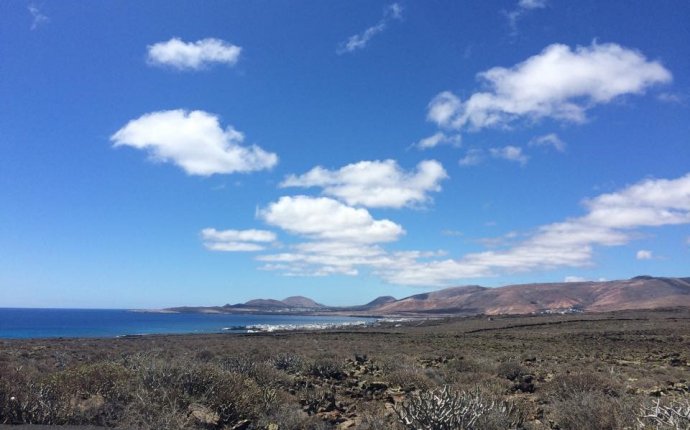
Weather in Gran Canaria Next Week
 After driving around the Pyrenees Mountains for a week I’ve changed scenery and have gone to the Canary Islands. I’ve been on the island of Gran Canaria, Lanzarote, La Graciosa and Tenerife and will be on La Gomera and La Palma next week. So far it has been great with amazing weather.
After driving around the Pyrenees Mountains for a week I’ve changed scenery and have gone to the Canary Islands. I’ve been on the island of Gran Canaria, Lanzarote, La Graciosa and Tenerife and will be on La Gomera and La Palma next week. So far it has been great with amazing weather.
I realize that many people have no clue where they Canary Islands are or much about them, so I figured it was time for another installment of “8 Facts You Might Not Have Known…”
1) They were not named after canary birds.
Despite the name, the islands were not named after canaries, the cute, chirping birds. It comes from the latin word for dog, “canaria”. One story is that when some of the first Europeans arrived, they found large dogs on the island of Grand Canary. In fact, they might not even even named after dogs at all, but rather after seals which used to inhabit the island, which the Romans called “sea dogs”.
2) It has the highest point in Spain.
Despite having the Pyrenees mountains in its country, the highest point in Spain is actually on the island of Tenerife. El Teide is 3, 718m (12, 198ft) high. There are other tall peaks in the Canaries as well including Roque de los Muchachos on the island of La Palma 2, 400 m (7, 874 ft). This mountain is of note because it is home to one of the largest collection of astronomical telescopes in the world, including the world’s largest telescope, the 10.4m Gran Telescopio Canarias. It’s high volcanic mountains which sit above the clouds makes it similar to the observing conditions you can find in Mona Kea in Hawaii.
3) The Spanish Civil War started here.
At the outbreak of the Spanish Civil War in 1936, Francisco Franco was the General Commandant of the Canaries, headquartered in Las Palmas, on Grand Canary island. He and his minions plotted their strategy here in the Canaries, out of sight and mind of the rest of Spain, before moving to the continent.
4) You can cook food over a volcano.
As I mentioned above, the Canary Islands are volcanic in origin. While there are no volcanoes currently erupting on the island, there was a great deal of activity on the island of Lanzarote between 1730 and 1736 when over 100 volcanoes appeared on the landscape. The last eruption was in 1824, but there is still a significant amount of heat just below the surface. If you enter Timanfaya National Park, you can visit El Diablo Restaurante where they have several demonstrations which show the heat just below the surface. In one demonstration they toss straw into a hole which bursts into flame due to the heat. In another they pour water down a whole which instantly turns into a tower of steam. At the restaurant, there is a 9m hole was which was dug to access the heat, the top of which is used as a grill. The temperature of the grill reaches 400C and uses no energy.
5) The islands were colonized concurrently with the Americas.
While the Canary Islands were known to the ancient Romans and Greeks, they never really grabbed the attention of Europeans until they began to sail across the Atlantic to the Americas. Columbus used the island of La Gomera as a staging point for his first trip to the Americas. Most of the older buildings you can find in the islands, especially in the city of La Laguna are very colonial in style. Unlike the Americas, however, the Canary Islands were not a colony but an actual part of Spain which they remain to this day.
6) The city of San Antonio, Texas was founded by people from the Canary Islands
If you remember the Alamo, then you should also take a second to remember the Canary Islands. The city was original founded by settlers from the Canaries and their descendants died fighting alongside Jim Bowie and Davy Crocket. The founder of the city of São Paulo, Brazil is also from the island of Tenerife.
7) It his home to a whistling language
On the island of La Gomera there is a language used to communicate over the large distances across valleys called “Silbo Gomero“. As technology changed the ease in which people could communicate, the language was in danger of dying out in the 20th Century. The government took measures to teach the language to children in school. The whistling is actually just a form of Spanish. The language is more used for announcements and news, not for personal conversation. It was listed as a “Masterpiece of the Oral and Intangible Heritage of Humanity” by UNESCO in 2009.
8) World worst airline disaster
The world’s worst aviation accident occurred on the island of Tenerife on March 27, 1977 when two Boeing 747’s collided on a foggy airport runway. 583 people were killed when KLM Flight 4805 hit Pan Am Flight 1736 during take off. Neither plane was supposed to be on Tenerife as they were diverted from Gran Canarias when a bomb was detonated on the runway. The airport had many more aircraft than it could handle and couldn’t fit all the planes at the gates. An investigation after the event by Spanish, Dutch and American teams concluded that there were a host of problems which lead to the disaster including language, not knowing where the planes were, casual terminology and pilot error. The accident lead to a host of changes in how plane crews and flight control towers talk to each other to avoid misunderstanding.